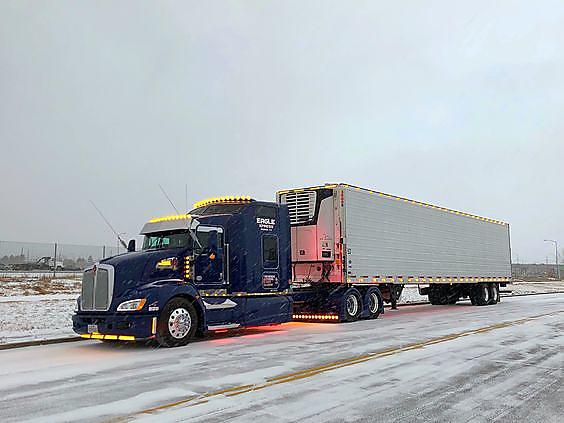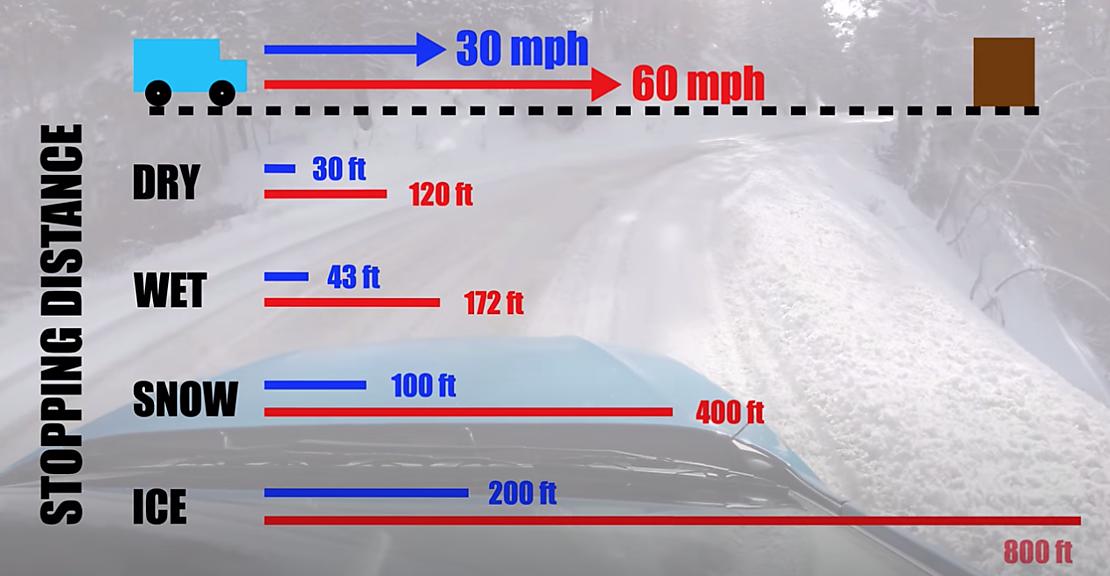When it comes to the Winter Months in the United States there is one thing for certain that you can normally expect to happen. That one thing to expect to happen is snowy weather when you least expect it. Today we want to educate you with some great tips to stay safe during the winter months and how to prepare for the worst. Let’s begin.

How to Prepare for Snow Storms
When it comes to being prepared for snowstorms the best thing you can do is overprepare with things to help you out in almost any situation. Snow and Ice are some of the most dangerous things to watch out for when on the Road during the Winter Months in the United States as the weather can often surprise you with Black Ice, Snow Drifts, and Deep Snow Storms that can leave you stranded if you are not careful.
A few tips to help plan for your next trip:
• Download Weather apps on your phone and turn weather alerts on
• Bring extra clothes to change into to provide more heat or to dry out
• Keep extra snacks and drinks inside of your vehicle in case travel becomes limited due to weather conditions
• Extra warm blankets to provide extra heat if your vehicle becomes stuck or broken down
• USB phone charger to keep your phone completely charged for emergencies
• Winter clothes such as jackets, pants, gloves, hats, boots, and reflective vests are a MUST
• Recovery tow straps can be used to get your vehicle out of a ditch, deep snow, ice, or out of a bind
• Keeping Deicer Fluid & an Ice Scrapper in your vehicle to remove snow and ice from the windshields before hitting the road.
• Jumper Cables, Flashlights, Flares, and Snow Shovels are added bonuses that are completely optional.
You can view our full selection of Recovery Tow Straps HERE
Driving in Snow Tips for Beginners
When it comes to driving in the snow for beginners the number one thing that anyone can do is to be prepared. As you seen with some of the tips above on how to prepare for a snowstorm you should ultimately do the same for driving.
A few tips to make driving in the snow easy!
Good tires for your vehicle – We personally recommend those who are consistently in snowy areas to use snow tires as they are designed for snow and ice in mind. Tires that are bald or made for summer use may become very challenging in conditions such as snow and ice. These tires can pose a real danger when driving your motor vehicle and should be used with real caution.
Keeping up with Maintenance – When it comes to maintenance and winter weather they go hand and hand. You will want to keep up to date with things such as Washer Fluid, Windshield Wiper Blades, Battery Charge, and Bulbs on your vehicle being replaced frequently as they go out. In the cold weather car battery charges become harder to keep charged and bulbs tend to go out more often due to issues with becoming warm. It may also be a great idea to bring a battery jump box or jumper cables in order to help your vehicle start if your vehicle’s battery becomes drained from the cold weather.
Inspecting your vehicle – Before hitting the road you will want to start your vehicle and let the vehicle’s heat from the engine remove the ice by using heat on the windshield and other windows in the vehicle. This helps to provide you with the full vision of the vehicle and prevents the snow and ice from flying off at other motorists when you are on the road. This can become very challenging if you are in a rush at times, so you will want to make sure to plan ahead when you are on hitting the road.

Removing Excess Snow – When it comes to removing excess snow it can be in a wide variety of different ways but if at all possible using these steps can help make your daily commute much easier. First, start by removing the extra snow off of the vehicle before you leave for your next location. Secondly, if you have time remove excess snow from your driveway to help to enter and exiting the driveway much simpler. By removing light layers of snow it becomes much easier to enter and exit the driveway compared to waiting till the last minute when the snow may have drifted or has become deeper from layers of snow.
Being Patient – When it comes to driving in winter conditions the last thing you ever want to do is be in a rush to get to your next destination. When braking you will want to brake well in advance for your stop in order to slow down slowly to prevent the vehicle from sliding. The same goes for taking corners too sharp or quickly you will want to avoid giving the vehicle acceleration around corners. If you believe there is a potential for ice or feel the vehicle moving around from under you, slow down. If the conditions become too challenging to continue going down the road it’s completely okay to pull over and wait on the city and state workers to clean up the roadways.

Tips on Winter Driving from the Pros
• Wash your car often as chemicals such as Brine or salt that is used to remove snow and ice from roadways can also quickly cause rust on motor vehicles. Remember to also wash under the vehicle and the wheel wells in order to remove potentially stuck rust-causing debris. If your vehicle is going to be used often in the winter remember it is a good rule of thumb to also wash often.
• Leave earlier in case of any other potential delays that are caused by bad weather such as vehicle accidents, icy conditions, snowdrifts, or even as simple as the windshield being frosted over from being cold.
• Avoid quick braking, quick accelerations, or using the gas in corners to avoid vehicles from sliding as it may be challenging to gain control of the vehicle again. If you need to corner remember to slow down BEFORE you turn. We often see a lot of people who fail at doing so and end up spinning out of control or hitting the guardrail in winter storms. Normal stopping distance can take 4x longer in snow and ice to get the vehicle stopped so give yourself plenty of room.
• Stay alert as other motorists might be putting themselves in danger on the motorways causing you to quickly lane change, swerve, or hard brake at times. Also, be extremely careful crossing intersections, coming to a stop at stoplights, or cars that are merging onto the highway as they may be going too fast to stop. Doing these steps you can ultimately stay in control during this winter season by using some of these tips to provide good driving habits.

Truck Driving in Winter Weather Safety Tips
Although many of these winter tips in this blog post apply to cars and pickup trucks, the same general ruleset can be applied in commercial driving applications as well. No matter if you are in a Moving Van, Dry Van, or Flatbed Trailer these tips can be used to help keep you safer on the road in winter weather conditions.
Truck Driving in Snow can be quite difficult at times but one of the main things that help truck drivers in Winter is the weight of the vehicle which helps you gain traction. Traction during the winter months can make all of the difference between an easy stress-free commute and one that makes you want to pull your hair out. The one thing that should be the deciding factor if you are hitting the road or if you wait till later to hit the road should be your confidence in being able to drive safely. If you don’t feel confident in the weather conditions you should immediately pull over when and where there is a safe place to do so.

Another winter tip for professional truck drivers is to inspect often from start to finish. Do regular inspections on brake conditions, tread wear, wiper blades, battery voltage, and to keep at least half a tank of diesel fuel for idling purposes as diesel fuel can gel up in cold climates causing diesel fuel to become much harder to start. When the temperatures dip into super cold conditions it is always a wise idea to leave your diesel truck running overnight at truck stops. Most diesel engines take very little fuel in order to remain at idle, as well as most newer model trucks have idle switches that were designed for these situations.
Frequently Asked Questions
What if I have never driven in snow before? – Chances are if you are from the south or other warmer parts of the United States you have never had the opportunity to drive in snow and that is perfectly okay. As stated in the blog the number one thing you can do is take your time, inspection your vehicle – especially the tread on your tires, leave in advance if you need to be at a place at a certain time, and go slow around corners and approaching stop signs or red lights.
How do I remove ice from my vehicle’s windows? – the best way is to stock up in advance on a can of de-icer that can be found at any supermarket hardware or car section for a few dollars. If the windshield is layered with thick ice you will want to spray the window frugally and then begin to scrape the windows using an ice scraper and brush. It’s a super good idea if you haven’t done so already to keep these in your vehicle.
Are Automatic Transmissions or Manual Transmission Cars Better in Snow? – This can vary on preference and skill on a person by person basis. However, if you know how to drive both equally as well the manual transmission by far will be the better of the two transmissions. This is due to being able to have more control of the gear, speed, and RPMs on your vehicle. In general, more control on the vehicle will normally equally the better option. If you lack the experience, knowledge, or a vehicle with a manual transmission this solution might not be ideal.
All Wheel Drive vs Front Wheel Drive vs Rear Wheel Drive Vehicle for Snow? – In order from best to worse it typically All Wheel Drive, Front Wheel Drive, and Rear Wheel Drive for the best personal vehicles in the snow. This is due to factors such as ice and snow conditions that can be challenging on Rear Wheel Drive that may cause the vehicle to slide around corners or drift.